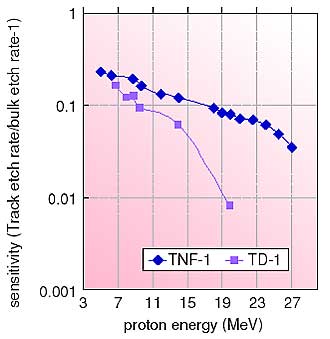When energetic charged particles (ions), like cosmic rays, are passed through a polymer film, the polymer chains around the ion track are ionized, chain scission occurs successively, and finally the chain bonding around the ion track becomes degraded. Such deteriorated regions are etched by immersion into a chemical agent, and small cavities are grown. The types (and energies) of incident cosmic rays can be determined from the depth of the cavities.
The capability of radiation sources to ionize materials is defined in terms of linear energy transfer (LET), which depends on the atomic number and velocity of the charged particles. Ions with larger LET bring about a higher density ionization, and the LET of ions with a greater velocity is smaller among ions with the same atomic number. Polyallyl diglycol carbonate (CR-39, TD-1) has been used as a good cosmic ray detector, but new track detectors having a higher sensitivity than CR-39 are desired in application fields such as space radiation dosimetry, dosimetry for heavy-ion cancer therapy, and so on. We have developed a new plastic, track etch detector (TNF-1) by the method shown in Fig. 9-6.
Fig. 9-7 shows a comparison of track-detecting sensitivities between TD-1 and TNF-1 for protons, which are the most abundant particles in the field of space radiation. It can be seen that TNF-1 detects higher energy protons compared with TD-1. TD-1 and TNF-1 were put into space and exposed to cosmic rays for 40 days on the Space Station. Cosmic rays with 2 keV/micrometer proved to be detected using TNF-1, but the lower limit of detection for TD-1 was an LET of 2.8 keV/mm. Thus, TNF-1 was confirmed to be a very useful dosimeter for the space environment.
The ability to detect lower-LET charged particles leads to increasing usage in various fields. In heavy-ion cancer therapy, it is important to minimize the ratio of the dosage of projectile fragments to the total dose, in order to prevent damage to normal healthy cells existing adjacent to the cancer cells. TNF-1 has been confirmed to be the most suitable material for this field. When fast neutrons pass through materials in which hydrogen atoms are contained, certain hydrogen atoms are emitted, and they are called neutron-induced recoiled protons. By measuring the quantity of the recoiled protons, the dose of incident neutrons can be determined. TNF-1 has been confirmed to have twice the detecting ability of TD-1 (pure CR-39). |


